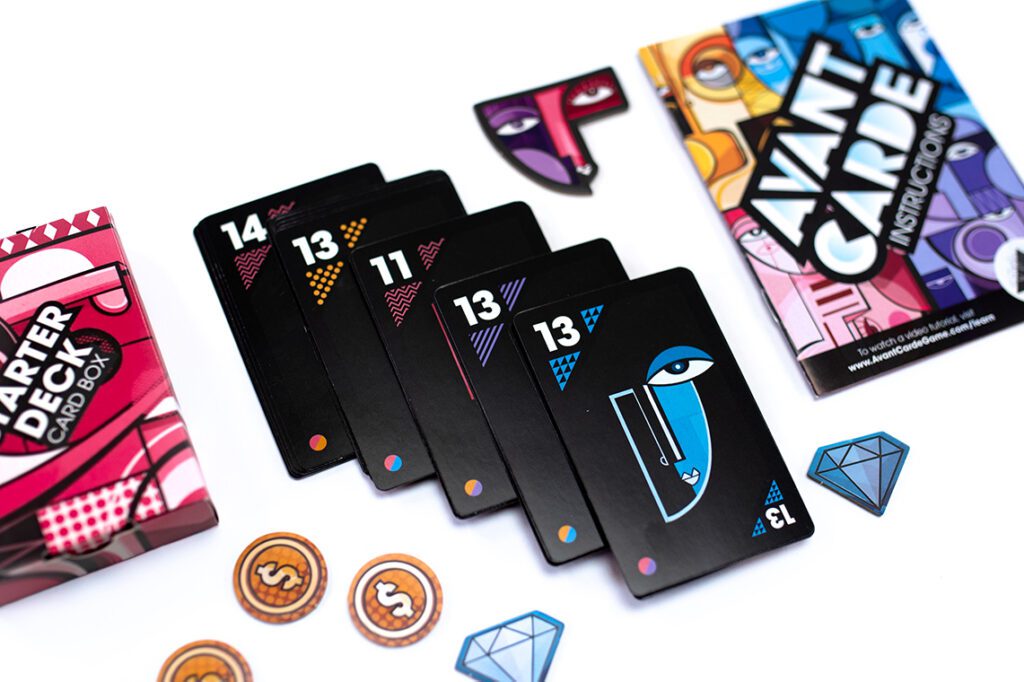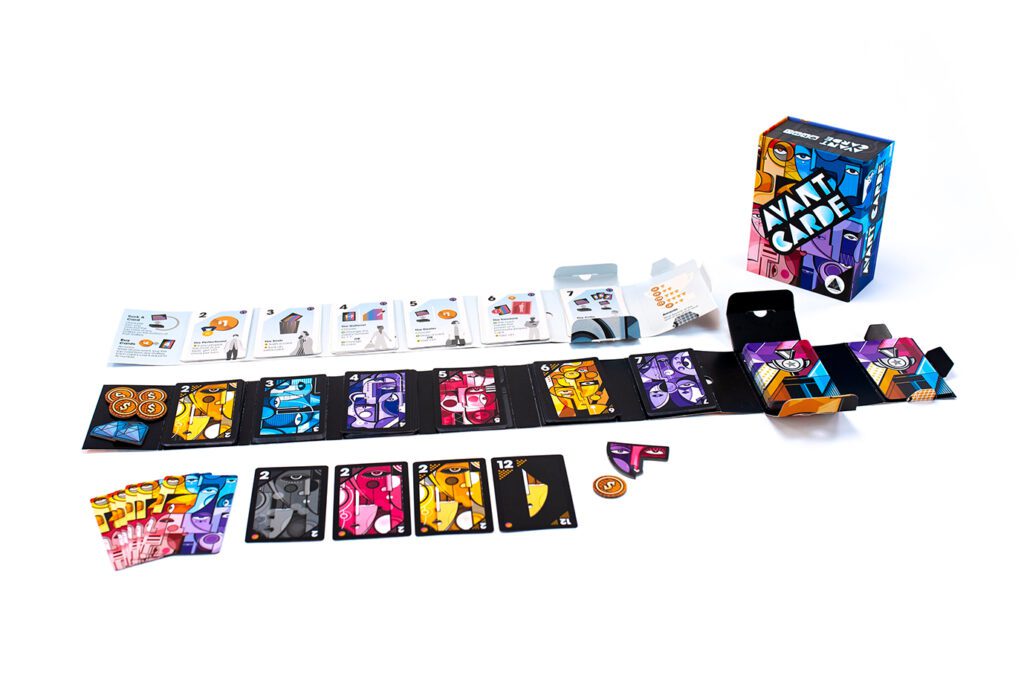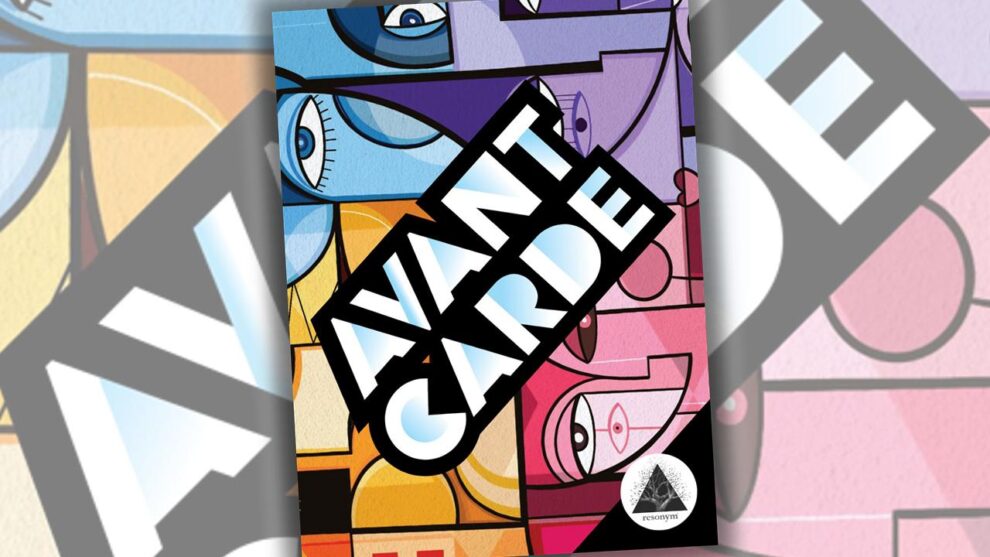Disclosure: Meeple Mountain received a free copy of this product in exchange for an honest, unbiased review. This review is not intended to be an endorsement.
As I think about the new deckbuilding and set collection game Avant Carde (2024, Resonym), I sit in an interesting position regarding my feelings about the game.
I have enjoyed my four plays and look forward to keeping the game in my collection. But not everyone who has joined me at the table has enjoyed it as much as I have. As a reviewer, life is always easier when there is general agreement at the table about the quality of a game’s design.
Avant Carde is a deckbuilding game. That means players—who are trying to score the most points by earning awards each round—begin the game with a poor and mismatched hand of cards, then slowly play these cards to earn money that will be used to buy better cards that do more interesting things as play continues. Based on player count, a certain number of award cards must be taken before play comes to a close.
So far, so standard, right? Avant Carde (designed by Mary Flanagan and Max Seidman) then elevates itself by offering simultaneous action by all participants, as players lay out cards from their hand. The game’s cards come in seven colors (two of which are only included in the not-so-powerful starter decks, making them harder to match) and numbers that range from 1-14. The ideal hand arrives when players are able to string a combination that can be played into their personal player area by putting the cards in order with at least one commonality, suit or number.
Let’s say your hand of seven cards includes a purple 14, which you play to the table first. You can next play either another 14, or any purple card, to ensure a match. Let’s say you next want to play a purple card, which happens to be a 2. Now you can play another 2 from hand, or another purple card. Stringing together an “UNO-style” combo in this way—particularly one that gets all seven cards out of your hand, since any unplayed cards are simply discarded at the end of the phase—feels just as good as the combos I might play in any of my other deckbuilding favorites, such as Clank!, Dominion, The Taverns of Tiefenthal, or Obsession.
And that’s all before we talk about the cards you can buy from the market at the end of each round, which introduce other powers and ways to slim a deck so that future turns set up better and juicier combos. Each card a player lays down in the play phase is worth a dollar to spend on new cards, before adding in any special powers that come from better cards. The narrow list of cards available in the Patron market deck (the game comes with Patrons as well as three alternate sets of card powers to change things up each game) make shopping rounds go quickly, with an additional “tuck” mechanic so that players could cycle the top-most card of a specific card type in the market to see if they can turn up a card color that is more beneficial to the deck being built by that player.

So…What?
Avant Carde features fun turns that occasionally come up aces, which made me, or the player sitting nearby pulling off a sweet combo, feel pretty clever. So, why haven’t other players been as excited as I have been during each game?
I do love deckbuilding games, and showing this game to both gamers and “muggles” (those who are not core hobbyists, or anyone confused by the gatekeep-ish term “deckbuilding”) revealed a divide that I expected to be less severe. Gamers seem to like Avant Carde as a filler that kicks off a game night, but interest in the four-player game I did with core hobbyists was losing steam by the midpoint. Muggles liked the cardplay, but the powers of new cards bought from the market didn’t get them excited the way gamers might get excited about the potential of a stronger deck.
After four plays, I see two significant gaps: the feeling that your hand plays you, and not the other way around. And, the lack of variability in the market cards.
With a hand of seven cards and limited rules for how to play those cards, most hands featured a player staring at the cards and looking for the best order to play cards in order to score a few bucks. That choice is essentially automatic—if a card I have in hand has a unique color AND number, that card is automatically getting discarded in most cases. Then I look to see if I have one overwhelming color, and try to play my cards around that. For many of a game’s early turns, you aren’t even thinking about which cards to play because only certain cards can be played in the first place.
With only six types of cards available in each game, and with a mechanic that restricts players from hoarding the money needed to save up for the best cards, I found myself wanting more varied cards to purchase almost immediately. The game comes with three sets of Patrons—the New Yorkers, the Tokyoites, and the Parisians, to shake up fatigue surrounding the powers of the base game.
Each game plays out a little differently thanks to these card sets, but not quite enough to extend the life of the game. The most important thing about cardplay in Avant Carde is sticking to a strategy of having the right colors all the time to keep combos going. (Even the rulebook pushes players to focus on one or two suit colors.)

Getting to the magical $8 watermark on a turn earns a player two award cards, instead of just one at the $6 mark. (Award cards are never purchased, just granted when players make their thresholds.) Trying to do that as many times and as quickly as possible became my overarching goal in both solo and multiplayer games, so I could exhaust the awards pool. Easier said than done early on, but once you start buying a lot of the same color cards and using the 3-value cards to trash cards and thin out your deck, good things begin to happen!
One thing that all players agreed on: the cubist-style artwork on the cards, drawn by Ishita Banerjee, is magnificent. Paired with the sexy box (and the magnetic close along with the card packaging solution), Avant Carde is a looker, one of my favorite stylistic productions of 2024. I didn’t catch one element when I first saw the cards, but Max and Mary told me that the number of eyeballs within each card image aligns with the card’s number…a cool touch. And the card colors each have a suit that makes very clear any differences for colorblind players.
As a production, Avant Carde is a home run.
But as a game, Avant Carde is still in a tricky place. I don’t mind enjoying a game significantly more than others—until I try to whip out games that I love a lot more than others who are lukewarm on additional plays based on their past experiences. By the fourth play, I was much less excited about Avant Carde than I expected, and that was further dampened by the feelings of players around the table.
Avant Carde is hanging around for now, and I’m really hopeful that more Patron cards come along to shake up the meta of the base game’s powers. And rolling up the cards in the packaging after each play is a tactile joy. I’ll begin my quest to find other players who enjoy Avant Carde as much as I do, to extend the life of the game in my groups.












Add Comment